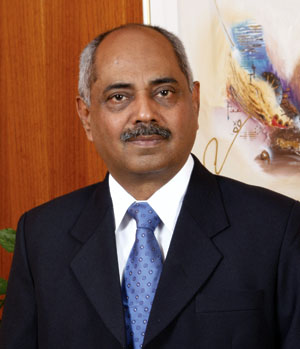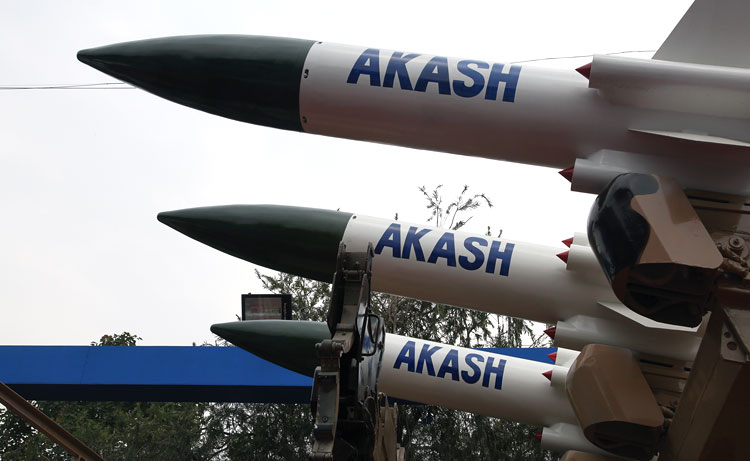- Prime Minister Narendra Modi inaugurates Aero India 2023 in Bengaluru; Releases Commemorative Stamp
- Defence Secretary meets delegations from Saudi Arabia, USA and Oman on the sidelines of Aero India 2023
- Foreign Ministers of 32 countries to attend Aero India 2023
- Embraer showcases the C-390 Millennium at Aero India 2023
'Going by the current order book of 26,000 crore, we are expecting significant turnover for the next financial year'
Anil Kumar, Chairman & Managing Director, Bharat Electronics Limited

SP’s ShowNews (SP’s): What is your vision for BEL?
Anil Kumar (Kumar): I would like to see BEL as a 25,000-crore company by 2020. But at the end of the day, we should make profits even as our turnover increases. Focus on research and development (R&D) is definitely the way forward as with our own R&D, we stand a better chance of adding more value to our products. We have 2,000-odd engineers working in R&D. To give a boost to the R&D set-up in BEL, we will make more investments in infrastructure so that our engineers are better equipped. We will look at technology transfer for acquiring advanced technologies wherever they are not available within our country.
We, however, want to reduce the dependence on foreign companies and build up skills in-house. We will explore joint ventures (JV) if it’s advantageous to us. I want a lean workforce, which is adequately skilled. Quality of products and marketing will be the other two key areas of focus.
Missiles, radars, C4I or network-centric systems (NCS), electronic warfare and homeland security are some of businesses we want to get into in a big way. We have identified nuclear power, homeland security and railways as our future growth areas. We have already entered two of these areas already- nuclear power instrumentation and homeland security. Work related to the railways - signaling and anti-collision devices- has just started. Our Panchkula unit is getting an order from the Coal India Ltd to develop an anti-collision device for dumpers at mines.
We will also focus on night vision devices like thermal imaging devices, both cooled and uncooled, and may manufacture detectors as these are not available in the country now. We will give a push to homeland security. As for another nuclear power, we are participating in a tender floated by the Nuclear Power Corporation of India Ltd and hope to get some order for electronic instrumentation for atomic power plants. It will be an additional business for our Kotdwara unit.

We are pursuing the C4I or NCS business in all the three armed forces. We have invested quite a bit of our resources in it. Tactical communication system, battlefield management system and battlefield surveillance system will all turn out into huge moneys-spinners.
SP’s: What is your sales target this year? How is the order book?
Kumar: We have some major projects lined up for Q4 and we are confident of surpassing last year’s turnover of 5,530 crore. The order book at the end of January 2012 is around 26,000 crore as compared to 23,600 crore in the beginning of FY 2012. Having received orders worth 6,000 crore in the first three quarters, we are expecting inflow of another 4,000 crore orders in the last quarter.
SP’s: Can you name some of your recent projects that you are proud of?
Kumar: Weapon locating radar (WLR) is one such project which we are quite satisfied about.
This project was proactively taken up by BEL with Electronics and Radar Development Establishment (LRDE), a DRDO lab. The indigenously developed WLR has met all the user requirements. We are also looking at a smaller and more compact version of this radar for mountainous terrains.
A major project we have taken up is the software defined radio (SDR) with which all three Services' requirements are being simultaneously addressed with variants. By June this year we should have the first model and by December, we should be able to offer it for user trials. The SDR has been designed in such a way that it can work with the legacy systems of the armed forces. Over the years, as the old ones are phased out, the SDRs will take their place.
The Ministry of Rural Development placed an order for six lakh Tablet PCs to carry out the socio-economic caste census and I am happy to note here that BEL rose to the challenge by supplying the required numbers in record time.
SP’s: What is your projection for the next fiscal?
Kumar: Going by the current order book of 26,000 crore, we are expecting significant turnover for the next financial year. A major share of the turnover will come from weapon systems, radars, fire control systems, network-centric systems, communication systems, electronic warfare, surveillance systems, tank electronics and smart cards.
Ever since the company’s inception, R&D has predominantly been the driving force behind BEL. Some of the key products which are currently under development are likely to make rich contributions to BEL’s business in the coming years. The company has also initiated diversification activities in the areas of nuclear instrumentation, solar energy, airborne radars, etc.
A major share of our turnover in the next two years will come from weapon systems, radars, fire control systems, network-centric systems, communication systems, electronic warfare, surveillance systems, tank electronics and smart cards. The company has also initiated diversification activities in the areas of nuclear power instrumentation, solar energy, airborne radars, etc.
SP’s: How is BEL doing on the export front?
Kumar: The company is targeting $42 million of exports this year. The total order book for exports is about $63 million.
Countries in Africa, Latin America, South East Asia, SAARC, Middle East and CIS countries are the markets for export of BEL products. The identified products are HF & VHF communication equipment, battlefield surveillance radar-short range, opto-electronic products like eye safe laser range finders, night vision devices, and solar products and components. Apart from products, contract manufacturing business from USA and Europe is also being addressed.
BEL is also closely working with various foreign aerospace and defence companies to secure business under the mandatory offset clause in the RFPs for Indian Defence Procurement. These companies have visited BEL’s facilities and based on their feedback, necessary action has been taken. Seven of our SBUs/Units have got AS 9100 Certification to address the aerospace business. Further, efforts are being made to establish long-term supply chain relationships with global players.
SP’s: Now that the MMRCA deal has come through what are BEL’s areas of interest in the project?
Kumar: As per the provisions of request for proposal (RFP), the vendor has to undertake offset contracts to a minimum of 50 per cent of the value of foreign exchange component of the commercial proposal. The total value of offset contracts in the area of BEL’s interest (electronic warfare, avionics and radar) is expected to be around $800 million. BEL has initiated discussions with vendors to secure a significant part of the above opportunity and have signed MoUs with OEMs and their major suppliers.
SP’s: Can you name some of your current R&D projects?
Kumar: Some of the ongoing R&D activities in BEL are in areas such as software defined radios, high capacity radio relays, tactical communication system, phased array radars, missile systems, Doppler weather radars, eye safe lasers and laser target designators, un-cooled and cooled thermal imagers, fire control systems, network-centric warfare & C4I command control systems, new generation electronic warfare and avionics technologies and new generation Sonars.
Some of the research and development (R&D) projects which are under development or in advanced stages of completion include weapon locating radar, Aslesha, Bharani, Doppler weather radar, software defined radio, routers, encryptors, 100W HF Radio for BSS, VHF radio for coastal surveillance, electro optic fire control systems, coastal surveillance system, towed array sonar, track and wheel integrated EW System for Army, Integrated ESM and ECM systems for Navy, missile warning systems for Air Force, combat management system for various ships, Akash for Army, L70 gun upgrade, eye safe LRF modules, multi-function hand held thermal imager, high repetition LRF for air defence, NBC Recce vehicle and sighting and fire control systems.
SP’s: Is BEL getting into any new joint venture (JV)?
Kumar: The amendments in DPP have given an opportunity to BEL to form JVs with leading global defence players and acquire the required critical technologies. The above approach will also put BEL in a position, wherein it can source state-of-the-art subsystems/products from such JVs and play the role of a system integrator for large strategic defence systems.
We are very actively pursuing a JV with Thales, France, for the manufacture of civilian and select defence radars. This JV is in advanced stage of finalisation.
Even though we will continue to focus on development of new technologies through in-house research and development (R&D), we will pursue JVs in specific areas where we do not have the technology.
We are in talks with Rafael for establishing a JV in the field of seekers and missile electronics. We are also in the process of identifying a third partner who can add value to the JVC and who is acceptable to both companies.
BEL is also discussing with BHEL for setting up a JVC for Solar PV manufacturing. The business plan for setting up of the JVC has been finalised and both the companies are in the process of obtaining board approvals.
SP’s: What is the impact of the new government guidelines on defence PSus and private sector corporations on BEL?
Kumar: The Indian market scenario for defence and civilian electronic products/ systems is rapidly changing. With the opening of the defence electronics market to private participation, the competition is likely to intensify. In this scenario, BEL is taking proactive steps to protect and further consolidate its leadership position in the Indian defence market while at the same time accelerating efforts to get into new business areas.
BEL is looking for new growth opportunities in areas aligned with BEL’s core strengths either through organic growth in existing/new areas or inorganic growth through JVs and such other methods.
As per the new production policy, preference will be given to indigenous design, development and manufacture of defence equipment if it can be developed within timelines required by the defence forces.
Also all equipment/weapon systems/platforms required as per longterm integrated perspective plan (LTIPP) will by and large be developed/ integrated/made within the country. To take advantage of these policy decisions, BEL has renewed its thrust on indigenous development either through in-house efforts or in collaboration with Defence Research and Development Organisation (DRDO)/academic institutions. BEL has made significant progress in the development of major systems listed in LTIPP like CCS, NCO for Navy, BMS, EW track and wheeled programme. BEL is also exploring possibilities of joint ventures to take advantage of ‘Buy and Make’ Indian category of defence purchases.
BEL has been increasingly outsourcing its requirements to private industry. At present about 30 per cent of our requirement is outsourced to the private sector. We are also partnering with private players for development programmes in technology areas. BEL has been outsourcing a large chunk of its hardware and software requirements for projects like Akash, WLR, CAR, etc.





